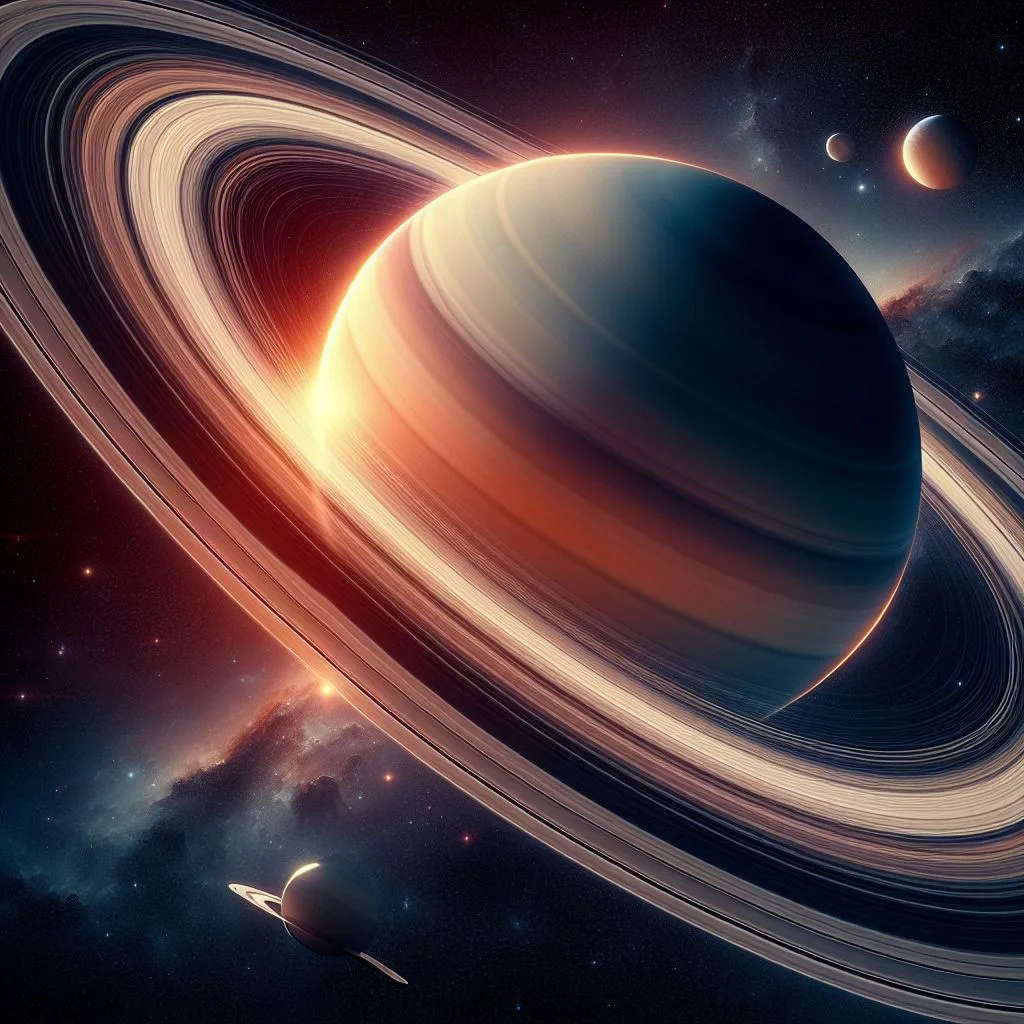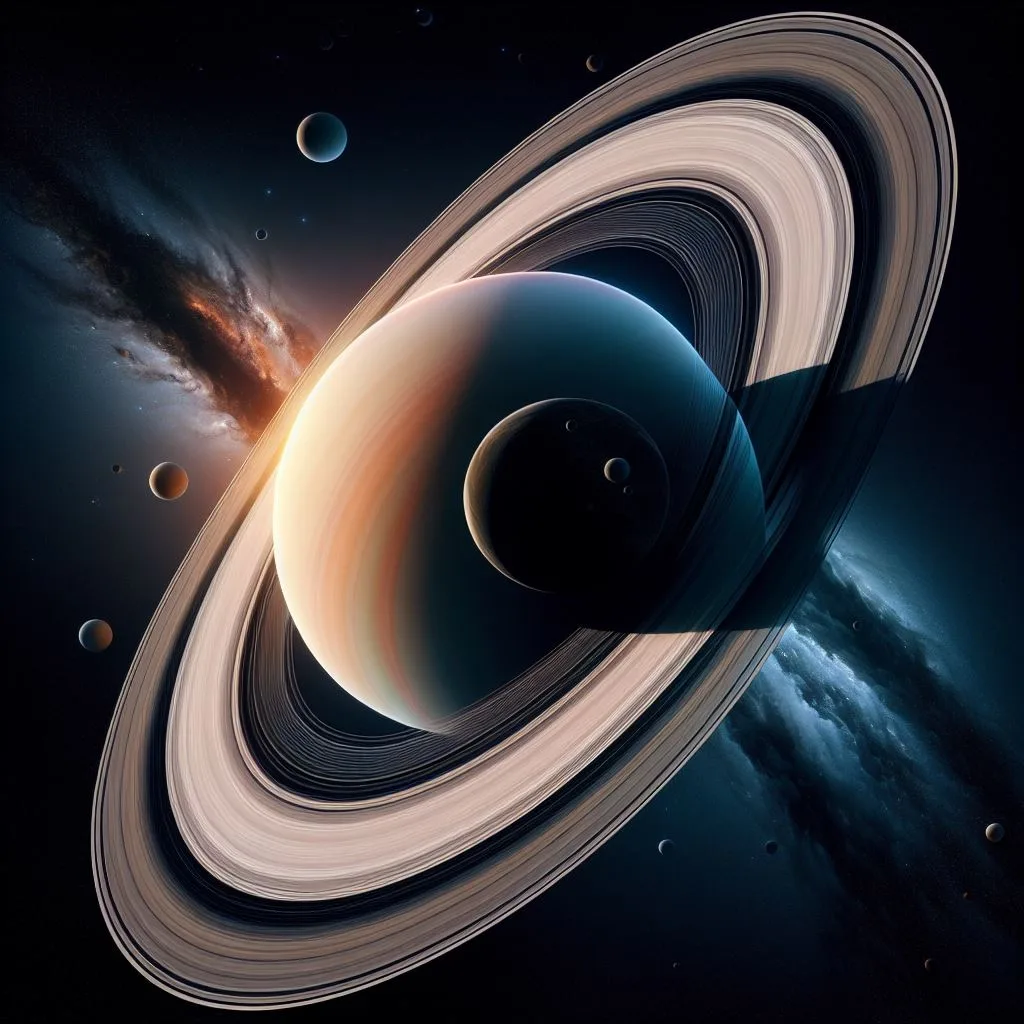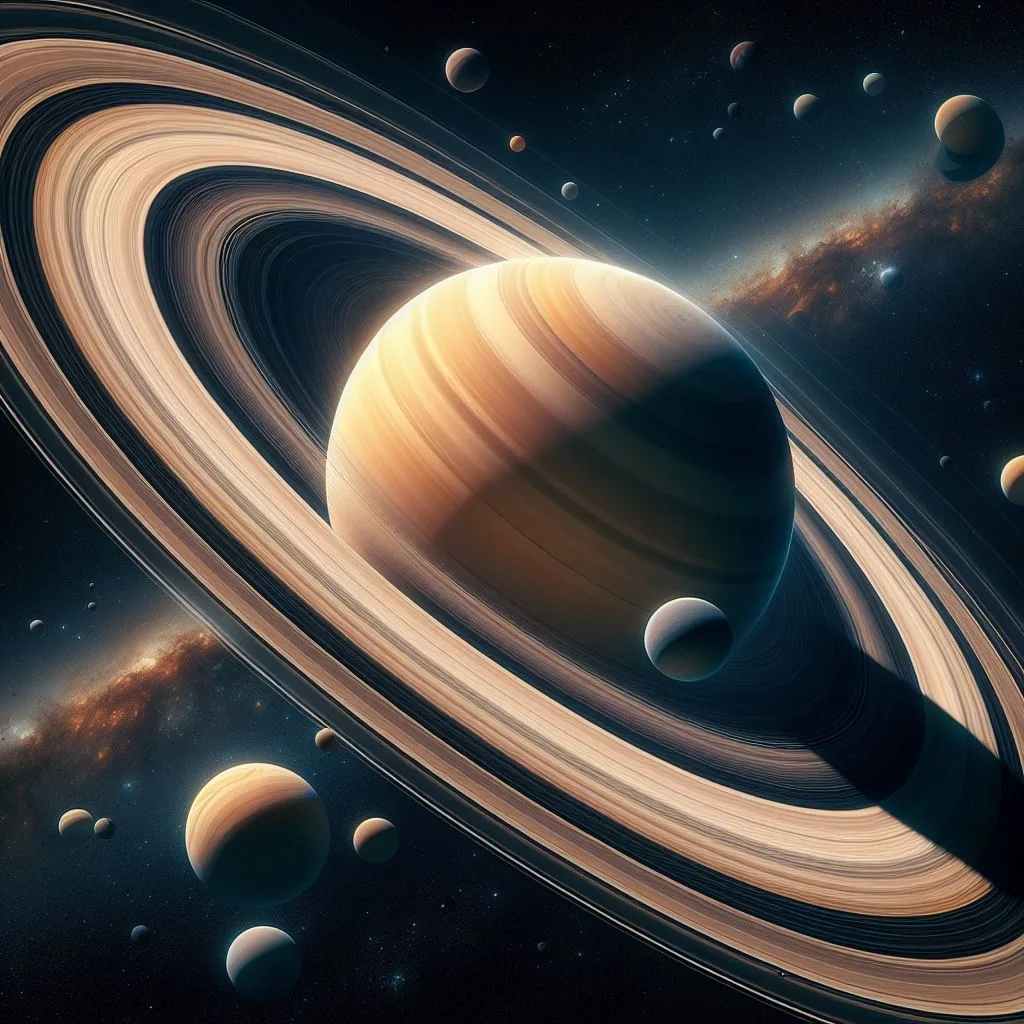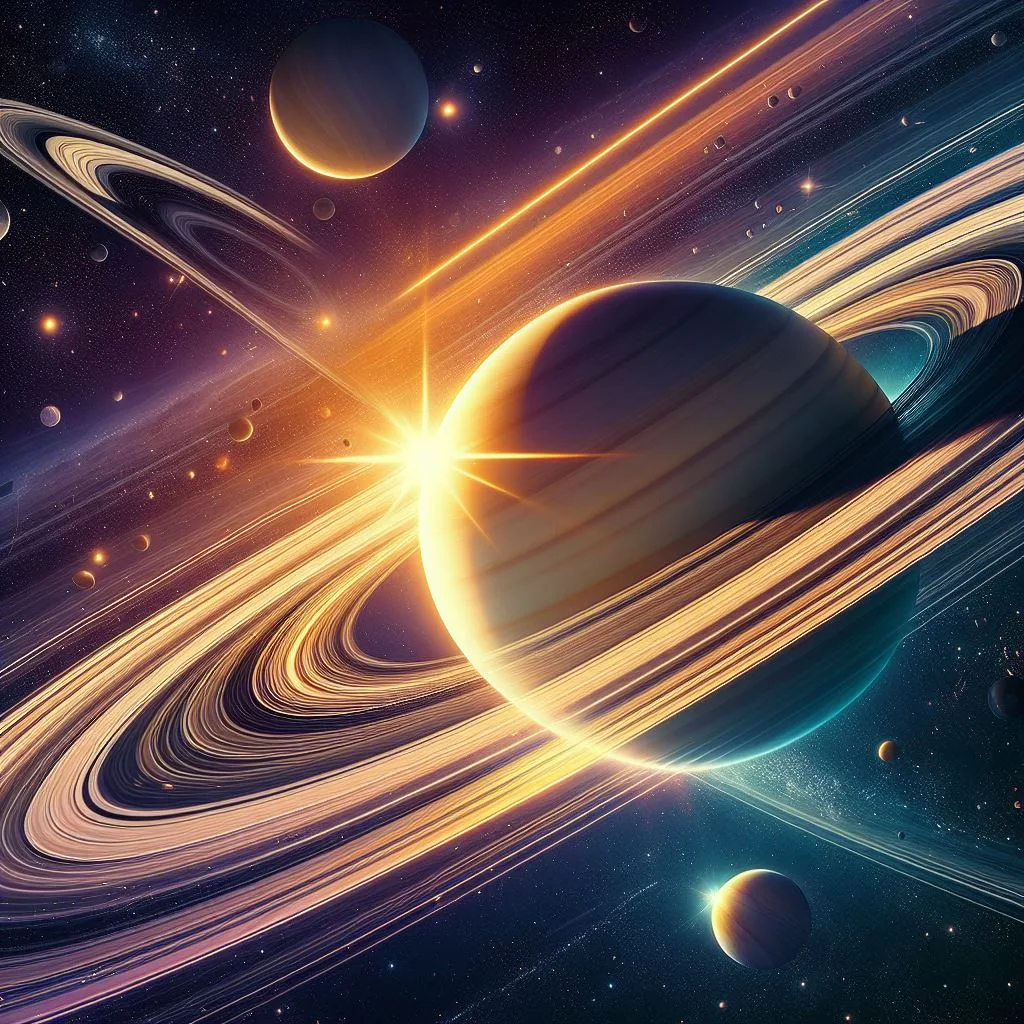
Saturn is one of the most recognizable planets in the solar system, thanks to its spectacular rings. But how did these rings come to be, and what are they made of? In this article, we will explore the origin and composition of Saturn’s rings, as well as how they are influenced by Saturn’s moons and the planet’s gravity. We will also learn some fascinating facts and myths about Saturn’s rings, and how they have inspired scientists and artists alike.

The Origin of Saturn’s Rings
Saturn’s rings are not a permanent feature of the planet. They are relatively young, compared to the age of the solar system. Scientists estimate that they formed about 100 million years ago, which is around the time that dinosaurs roamed the Earth.
There are different theories about how Saturn’s rings formed, but the most widely accepted one is that they are the remnants of a moon or a comet that was shattered by Saturn’s gravity. As the moon or the comet approached Saturn, it was torn apart by the planet’s tidal forces, which are stronger near the equator than near the poles. The debris then spread out into a thin disk around Saturn, forming the rings we see today.
Another possible scenario is that Saturn’s rings are the result of a collision between two or more moons, or between a moon and an asteroid. The impact would have created a cloud of dust and ice, which then settled into a ring system around Saturn.

The Composition of Saturn’s Rings
Saturn’s rings are made of billions of particles, ranging in size from dust grains to boulders. Most of these particles are composed of water ice, but some also contain traces of rock, metal, and organic compounds. The rings are divided into several sections, named alphabetically from A to G, with gaps and divisions between them. The main rings are A, B, and C, which are the brightest and widest. The other rings are much fainter and narrower, and some are only visible with powerful telescopes or spacecraft.
The rings vary in color, depending on their composition and thickness. The inner rings are more reddish, because they contain more dust and impurities. The outer rings are more bluish, because they contain more pure ice and reflect more sunlight. The rings also change in brightness and color with the seasons, as Saturn’s tilt and orbit affect the angle of sunlight hitting the rings.

The Influence of Saturn’s Moons and Gravity
Saturn’s rings are not static, but dynamic and constantly changing. They are shaped and maintained by the gravitational interactions between Saturn, its moons, and the ring particles themselves. Some of these interactions create interesting features and phenomena in the rings, such as:
1. Shepherd moons
These are small moons that orbit near the edges of the rings, and keep them from spreading out or dispersing. They also create gaps and divisions in the rings, by clearing out the particles in their path. Examples of shepherd moons are Pan and Daphnis in the A ring, and Prometheus and Pandora in the F ring.
2. Resonances
These are situations where the orbital periods of the moons and the ring particles match up, creating a repeating pattern of gravitational pulls and pushes. Resonances can cause the rings to become more dense or sparse, or to form waves and ripples. A resonance with the moon Mimas causes the Cassini Division, the largest gap in the rings. The Encke Gap comes from a resonance with the moon Pan. It is a smaller gap in the A ring.
3. Spokes
These are dark streaks that appear in the B ring, and rotate with the ring. Lifting the dust particles from the ring, electrostatic forces create the spokes. The bright background makes the dust particles visible. The spokes are more prominent when Saturn is near its equinox, when the Sun is shining edge-on to the rings.
4. Braids
Twisted strands of ring material form in the F ring, Saturn’s outermost ring. The F ring is very thin and unstable. The shepherd moons Prometheus and Pandora constantly perturb it. Sometimes, these moons pull out clumps of material from the ring, creating long streamers that wrap around the ring like braids.

The Facts and Myths about Saturn’s Rings
Saturn’s rings are not only a scientific wonder, but also a cultural and artistic inspiration. Here are some facts and myths about Saturn’s rings that you may not know:
1. The rings are not solid
Contrary to popular belief, Saturn’s rings are not a solid disk, but a collection of individual particles. If you were to fly through the rings, you would see gaps and spaces between the particles, and you would not encounter much resistance. However, you would also face the risk of colliding with the particles, which could damage your spacecraft.
2. The rings are not flat
Although the rings appear flat from a distance, they are actually slightly warped and tilted. This is because of the gravitational influence of Saturn’s moons, which tug on the rings and make them bend and twist. The rings also have some vertical thickness, which is about 10 meters on average, but can vary depending on the density and size of the particles.
3. The rings have a name
People in ancient times called Saturn Cronus, the Titan leader and Zeus’ father. Cronus’ wife Rhea, Zeus’ mother and the fertility goddess, gave her name to the rings. The name Rhea means “flowing” or “streaming” in Greek, which reflects the movement and appearance of the rings.
4. The rings have a sound
In 2004, the Cassini spacecraft recorded the radio emissions from Saturn’s rings, and converted them into audible sounds. The result was a series of eerie noises, ranging from hisses and crackles to whistles and chirps. The ring particles and Saturn’s magnetic field interact and cause the sounds. The interactions create electrical currents and sparks in the rings.
5. The rings have a rainbow
In 2017, the Cassini spacecraft captured a stunning image of a rainbow-like effect in Saturn’s rings, called a “ring rain”. Sunlight refracts through the ice crystals in the rings and causes the ring rain. The refraction creates a spectrum of colors. The ring rain is more visible near the equinox, when the Sun is shining at a low angle to the rings.

The Conclusion
Saturn’s rings are one of the most amazing and beautiful sights in the solar system. They are a testament to the power and complexity of nature, and a source of wonder and curiosity for humans. Saturn’s rings become more appreciable and marvelous to us when we learn their formation, composition, and interactions with Saturn and its moons.
Sources
- Saturn Information and Facts | National Geographic
- Saturn | Facts, Size, Temperature, Atmosphere, Color, Rings, & Moons | Britannica
- Saturn – Kids | Britannica Kids | Homework Help
- Saturn News — ScienceDaily
- What Are the Colors in the Visible Spectrum? | HowStuffWorks
- All About Saturn | NASA Space Place – NASA Science for Kids
- Shepherd Moons | The Planetary Society
- Cassini’s Division | astronomy | Britannica
- Encke’s gap | astronomy | Britannica
- Spinning spokes in Saturn’s rings | The Planetary Society
- Saturn’s F Ring | The Planetary Society
- Rhea | Greek mythology | Britannica
- The Eerie Sounds of Saturn’s Rings | NASA







I’ve been following this blog for years and it’s amazing to see how much it has grown and evolved Congratulations on all your success!
I love how this blog gives a voice to important social and political issues It’s important to use your platform for good, and you do that flawlessly
Hey people!!!!!
Good mood and good luck to everyone!!!!!
Thoroughly insightful read, or so I thought until I realized it was The expertise shining through. Thanks for making me feel like a novice again!
The thoughtful analysis has really made me think. Thanks for the great read!
This article was a joy to read. The enthusiasm is contagious!
Appreciate the balance and fairness, like a judge, but without the gavel.
The way you break down ideas is like a chef explaining a recipe, making hard to understand dishes seem simple.
The depth of The research is impressive, almost as much as the way you make hard to understand topics captivating.
Testament to The expertise and hard work, or The ability to make me feel utterly unaccomplished.
This comprehensive article had me hanging on every word, much like I would during a late-night chat.
The insights are like a sunrise, bringing light and warmth to new ideas.
The attention to detail is as attractive as it is thorough. I appreciate a person who notices the little things.
The post was a beacon of knowledge. Thanks for casting light on this subject for me.
The Writing is like a favorite coffee shop where the drinks are always warm and the atmosphere is inviting.
The creativity shines through, making me wonder what else you could do with such a vivid imagination.
I appreciate the clarity and thoughtfulness you bring to the topic of the state of the country.